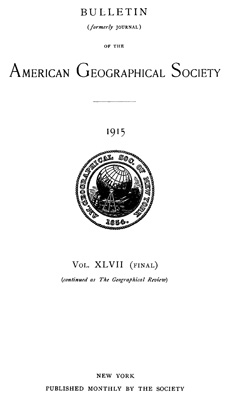| THE PEOPLES OF NORTHERN AND CENTRAL ASIATIC TURKEY
By Leon Dominian
[Maps facing pp. 852 and 868.]
The peoples and ideas emanating from within the realm which still bears the name of Turkey have left an indelible mark on the rest of the world. Crossed by some of the great highroads of history, the land is stirringly inspiring in every aspect in which it is beheld. Its heritage of memories and the prestige of a happier and grander past are undisturbed by touches of sad decline. The foundations of our progressive spirit were laid in that eastern region. It is the seat of our civilization and the cradle of our religion. From a purely scientific standpoint, its human grouping and surface configuration present highly interesting interdependence. This article will be confined mainly to a study of this relation. Grateful acknowledgment is made to Councilor Madison Grant for new views and important additions suggested during the revision of the proof.1
The region is divisible into six major geographical sections. Each forms a background against which distinct types of the human family are displayed. The various groups differ from one another by religion or language, often even by race. A fringe of fresh and verdant coastland which surrounds the elevated shelf of Asia Minor is largely Greek and Christian. The only foothold which Western thought, art or temper ever obtained in Asiatic Turkey is found within this wave-lashed strip of land. The plateau-heart of Anatolia is predominantly Turkish and Mohammedan. The Christian element scattered on its steppelike surface is unable to assert itself and yields to Oriental ascendancy. The high and broad mountain masses which border it on the east are homelands of the Armenoids generally Christians, sometimes Mohammedans, but almost always characterized by broad-headedness accompanied by a peculiar flattening of the back of the skull. Beyond this mountain barrier Asiatic Turkey becomes entirely Semitic, being mainly Arabian in speech and overwhelmingly Mohammedan in creed. Three main regions characterize this southern area. The long and narrow corridor ...
1 The writer is also indebted for valuable suggestions to Professor R. J. H. Gottheil of Columbia University and to Dr. E. Banks, late Director of the Mesopotamian Research Expedition, for many of the photographs reproduced with the text. | 